How We Talk to Our Young Kids About AxSpa
Becoming a parent brings so many unanticipated joys and challenges, but one my husband and I never thought about before was how we would talk to the kids about AxSpa, its symptoms, and how we can continue to be happy and healthy as a family. Nearly 10 years ago, Keegan, my husband with AxSpa, was diagnosed after X-rays showed SI joint fusion, leading to long discussions of whether we’d even be able to have kids at all. (He’d end up needing to be the primary caregiver.)
Luckily, Keegan responded well to treatments and after 2 total hip replacements, he’s doing better than I’ve ever seen him. With babies, most of the challenges focused around Keegan picking up the kids off the floor, playing with them during a flare up, feeding them, etc. But now that our 4-year-old daughter is beginning to ask questions, we’ve had to figure out how to talk about AxSpa with the kids.
1. We’re honest without scaring the kids
It’s always complicated when we need to talk to our daughter, Kaya, about Keegan’s AxSpa. We don’t want to scare her into thinking something bad is going to happen to Keegan, but we also don’t want her to think that it’s “no big deal.” Our first conversation focused on why “Dad needed to rest on the couch all day.”
Luckily, Daniel Tiger has an episode on being sick and they have a song called, “When you’re sick, rest is best.” We let her know that her dad often gets sick, like how she gets a cold, and needs to rest. His body sometimes hurts and he feels very tired. But we tell her not to worry because he’ll get better soon and get to play with her like usual in a day or two.
2. We include them in caregiving (within reason)
When she was 3-years-old, Kaya shocked me when she asked, “Can I help with Dada?” I didn’t understand what she meant, but Keegan was on the couch resting from a particularly bad flare-up. As I brought him pain medication, a heating pad, and a blanket, I saw Kaya trying to tuck him in. I realized she wanted to help him feel better, too.
While I don’t advocate for parentifying our kids, I do wonder if there’s an innate sense of caring that kids have toward their parents even at this young age. Nowadays, when Kaya asks if she can help, I find ways of including her. Then, she feels like she’s a part of of the care team, but only if she wants to be.
3. We let them ask questions
Kids are naturally curious, and Kaya is no stranger to that. Our second kid, Elijah, is still learning to form sentences, but I see him extra curious when Keegan (the stay-at-home parent) isn’t his usual self. Why is he resting in bed all day? Is he okay? Kaya often asks questions about Keegan’s body. Why does this happen? How can we help him feel better? When will he get better? (One of the hardest questions to answer.) I answer honestly but try not to offer too many details, as I’ve found it overwhelms kids.
Typically, I’ve offered more to Kaya as she gets older and she can understand more complex concepts. For example, pain is a strange concept to little kids. We’ve had to talk about different types of pain, like consistent pain versus pain when moving. Nonetheless, we’ve found answering her to help her not feel as afraid of what’s happening to her dad.
Other AxSpa parents out there—how have you discussed the disease with your kids? What’s been the most helpful to keep in mind during those discussions?

Join the conversation